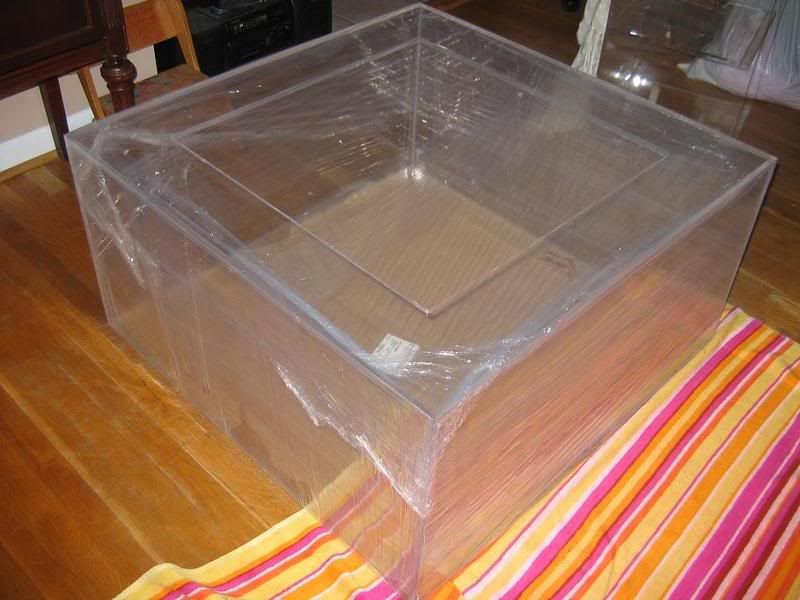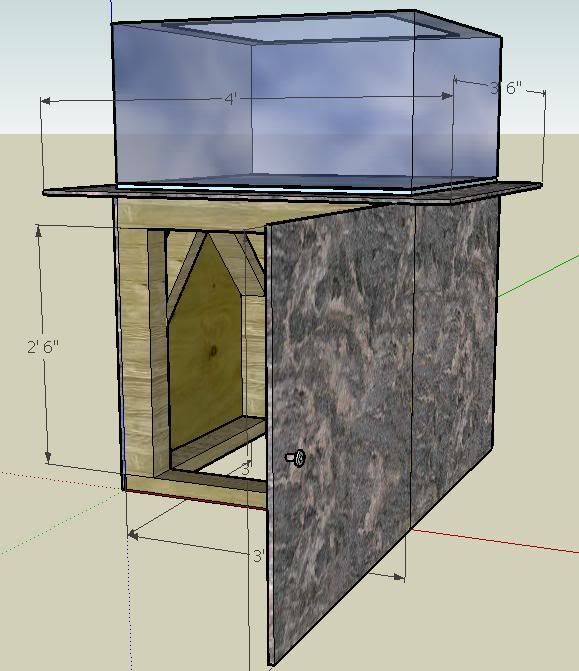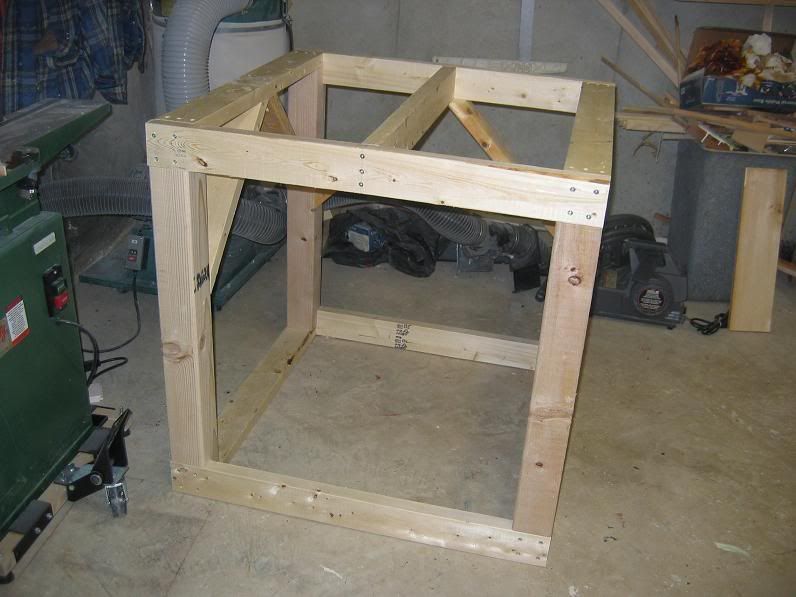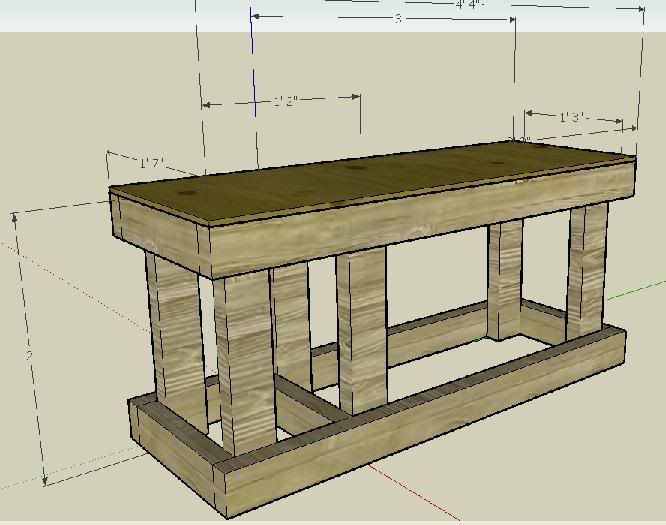Concept:
One of my dreams was to duplicate the oyster reef environment of the Chesapeake Bay as best I can without predation. I had a tank and sump built for this a couple years back, and almost finished a stand but personal troubles in my life have caused me some delay. The tank is a 101 gallon cube (36"X36"X18"), and the sump/refugium is 36"X18"17". The tank will have live sand from the Chesapeake Bay, and I'm going to try a mud bottom for the refugium. I'm thinking about serious reefkeeping like lighting, perhaps even LED if I can save enough money. It's not wattage and intensity that I'm after, but rather I want to duplicate lunar cycles, daylight and nighttime lighting transitions and seasonal variances in an attempt to induce spawning behavior. I hope to obtain filtration using live filter feeding organisms, oysters and perhaps mussels, tunicates, sponges, etc. although I realize that I'd have to find some way to supplement feeding. The sump will hopefully be a good supply of planktonic critters, although I may try to build a plankton reactor later on if that doesn't work. I'm not sure yet about what macro algae I'll use in the sump, but I might try and find some local stuff before moving on to non-Maryland species.
Animals will be collected from the Bay that live side by side in this environment:
Several striped blennies (Chasmodes bosquianus) - striped blenny which will be the feature fish of this tank
Hysoblennius hentzi - feather blenny if I'm lucky enough to catch any
Naked goby
Skilletfish
Northern pipefish
Ghost shrimp, hermit crabs, snails, etc. for clean up crew that live in the bay.
just about any critter that comes in on the rocks (fish will not be introduced for 6 weeks after the tank cycles and they are QT'd to reduce parasitism).
I may try my luck at some of the other species of fish too eventually, maybe even a hogchoker.
Biological Filtration:
I'll attempt another reefkeeping technique, live rock. However, the rock in my area of the bay typically is composed of clay and is of no biological use. So, my goal is to collect or plant cinder blocks or artificially made live rock (cement based) and build the oyster reef on that foundation. Using Bay substrate and rock when possible will help establish the biological filtration of the tank quickly, so maybe not much cycling involved.
Ecological Simulation:
The Chesapeake bay is brackish and the salinity varies based on rainfall and runoff, but these fish have bred in captivity with a salinity of 1.015 or so. Temperatures range from winter cold to brutally warm in the shallows of the bay, yet all of these fish thrive in this environment. I might even use a controller to simulate seasonal temperature changes, although not as extreme as the shallows of the Bay. Chasmodes bosquianus and the other fish are also found in Florida waters, so I don't think that temperature is an issue. Water parameters in the Chesapeake are constanty changing too, making it tough for sensitive species to thrive there. These fish live all year long with temperatures fluctuating from 40's to even upper 80's and salinity ranging from near fresh water to near ocean salinity in the Bay. Even the invertebrate species found in this biotope have to endure severe fluctuations.
Lighting:
Probably T5s, but am thinking about LEDs. Either way, my goal is to simulate as best as possible moonlight phases and seasonal lighting photo periods to try and induce spawning behavior.
Water Quality:
I plan to not use a skimmer and rather go with using filter feeding organisms, especially in the sump, along with cultivating macro algae for nutrient export. I think that most of the invertebrates will be hydroids, hardy anemones, tunicates, oysters, barnacles and mussels, and other filter feeders. Eventually I may use supplemental planktonic feed products perhaps. These inverts don't need as much light. In addition, the bay waters are pretty much mostly murky and filled with nutrients (both natural and, unfortunately, man introduced). Of course, frequent testing and water changes will be in my regimen to make sure that things go well. My main concern isn't so much the inverts here, but getting these fish to breed and thrive. If the biotope works out and I can keep all of these critters successfully, then so much the better Also, my other concerns include making sure that the life in the tank benefits from the amounts of nutrients at any given time (and I will have to chart and monitor what levels are best), at the same time having water clarity good enough to study the inhabitants. Top off water will come via using an RO/DI unit.
Current:
Another thing that I'd like to simulate is the tide and water movements, not lowering the water but currents. I can use directional flow to simulate water moving in and out of the mouth of a tidal creek for example, where a dock with an oyster reef may reside and form the habitat that I'm trying to duplicate. Not only will this help keep the critters feeling at home, frequent current and no dead zones in the tank should help with algae control. There are plenty of algae eating snails and probably hermit crabs too in the bay. I can keep them well stocked in my tank. They should be easy to collect. The fish should leave them alone.
Other issues:
In addition to placing DIY rock in the bay, I think that I can also make a basket/milk crate and fill it with oyster shells to collect animals. I'll need permission and a good location to place these, that is the next issue. The oyster shell basket will allow me to easily collect greater numbers of blennies, much more than the netting techniques that I've been using. I may also get more species diversity this way, including invertebrates.
Now all I need to do is find a place to put my DIY rock and my oyster shells. I've thought about placing them below a major bridge piling or perhaps a public pier. But I think that the best approach is to find someone who has access to private pier that would give me permission to place my baskets. Not an easy task for sure.
Another issue surrounds the collection of oysters. In Maryland, I have to be careful to collect in designated areas. Even though they aren't for consumption, I need to make sure that I'm compliant with local laws which change frequently. Another option would be to buy some fresh oysters directly from a waterman, right off the boat. It will cost me some money, but at least I'd know that I'm legal.
I think that in this system there may not be a wrong way to do it simply because these animals are so hardy. That said, I'd like to find a successful system and give these animals optimal conditions... This system won't have the color and beauty of a reef, but it will have it's own appeal. Actually, the male striped blenny gets extremely colorful during spawning! If that happens then I'll know I'm on the right track. Keeping oysters alive is what drives my goal of using a natural unskimmed filtration method with heavy use of macro algae for nutrient export. Also, I was hoping to find a bunch of tunicates to put in the fuge as well and a few other filter feeders too for more filtration. I may have to supplement feeding to keep them alive with purchased planktonic foods, but still it would be very cool to succeed at this. The creation of this biotope is a goal, but having an accurate and complete one might be out of the question. The blennies are the feature fish, so those will be my main concern, and that is creating a good breeding habitat with the simulation of an accurate biotope. So, my goal of keeping filter feeding invertebrates might not be doable. I'm going to give it a try though.
I have no idea what problems I will encounter. Algae blooms are a primary concern, also perhaps parasitism... I have a QT system already in place, so maybe that will help.
Here are some pics of my build so far:
Tank

Sump

Stand Plans

Stand Build


Sump Stand

I found a very cool YouTube video that shows the biotope that I'm trying to simulate:
You Tube Oyster Reef
I'm going to try and duplicate this environment as best I can. Most of the fish you see in this video are gobies, but you get a good look at the blennies at the end of the video (last minute). It would be very cool to exactly duplicate this with oysters and barnacles, but I don't think that it will be possible. Anyway, enjoy the video. In the mean time I have a lot of work to do to get this project going again...next update will be hopefully in the next month or so, maybe sooner.
Edited by Chasmodes, 22 November 2010 - 05:39 PM.








